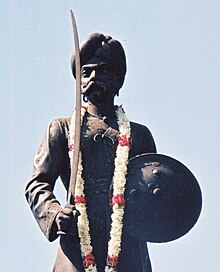കെംപെ ഗൗഡ I
കർണാടകയിലെ വിജയനഗര സാമ്രാജ്യത്തിന്റെ കീഴിൽ പതിനാറാം നൂറ്റാണ്ടിൽ സേവനമനുഷ്ഠിച്ച ഒരു പ്രഭുവായിരുന്നു കെംപെ ഗൗഡ ഒന്നാമൻ. ബെംഗളൂരു എന്ന ആധുനിക നഗരത്തിന്റെ സ്ഥാപകനും നഗര പിതാവുമായി അദ്ദേഹം കണക്കാക്കപ്പെടുന്നു.[2] നിരവധി തടാകങ്ങളുടെയും ജലസ്രോതസ്സായി പ്രവർത്തിക്കുന്ന നിരവധി കുളങ്ങളുടെയും നിർമ്മാണം ഉൾപ്പെടെ നഗരത്തിന്റെ അടിസ്ഥാന സൗകര്യ വികസനത്തിന് നൽകിയ സംഭാവനകൾക്കും ആസൂത്രണം ചെയ്ത നഗരത്തെക്കുറിച്ചുള്ള കാഴ്ചപ്പാടുകളുടേയും പേരിൽ അദ്ദേഹം ആദരണീയനാണ്.[3] ഇന്ത്യയിലെ സാങ്കേതികവിദ്യയുടെയും നൂതനത്വത്തിന്റെയും തിരക്കേറിയ കേന്ദ്രമായി അറിയപ്പെടുന്ന ബെംഗളൂരുവിലെ ആധുനിക മെട്രോപോളിസിന്റെ സ്ഥാപക പിതാവായി അദ്ദേഹം ഓർമ്മിക്കപ്പെടുന്നു.[4] എല്ലാ വർഷവും ജൂൺ 27 കെംപഗൗഡ ദിനമായി ആഘോഷിക്കുന്നു.[5]
കെംപെ ഗൗഡ I | |
|---|---|
 യലഹങ്ക നാടിന്റെ നേതാവ് (വിജയനഗര സാമ്രാജ്യംത്തിന്റെ കീഴിലുള്ള ഒരു നാട്ടു രാജ്യം) | |
| ജനനം | ഹിരിയ കെംപഗൗഡ 27 ജൂൺ 1510 |
| മരണം | 1569 (പ്രായം 58–59) |
| അന്ത്യ വിശ്രമം | കെമ്പപുര, മഗദി, രാമനഗര ജില്ല 13°00′53″N 77°04′53″E / 13.0146°N 77.08149°E |
| മറ്റ് പേരുകൾ | നാദപ്രഭു കെംപെ ഗൗഡ, കെംപെ ഗൗഡ |
| അറിയപ്പെടുന്നത് | ബെംഗളൂരു കോട്ടകെട്ടിയ നഗരം |
| മുൻഗാമി | കെമ്പനഞ്ജെ ഗൗഡ |
| പിൻഗാമി | ഗിഡ്ഡെ ഗൗഡ |
| കുട്ടികൾ | ഗിഡ്ഡെ ഗൗഡ |
| മാതാപിതാക്ക(ൾ) | കെമ്പനഞ്ജെ ഗൗഡ, ലിങ്കാമ്മ |
ആദ്യകാല ജീവിതം
തിരുത്തുകഹിരിയ കെംപെ ഗൗഡ (കന്നഡ ഭാഷയിൽ "മുതിർന്നയാൾ" എന്നാണ് ഹിരിയ എന്ന വാക്ക് വിവർത്തനം ചെയ്യുന്നത്) ബെംഗളൂരുവിലെ യെലങ്ക പ്രാന്തപ്രദേശത്ത്[1] മൊറാസു വൊക്കലിഗ സമുദായത്തിൽ,[6] ഏതാണ്ട് 70 വർഷത്തിലേറെയായി യെലങ്കയുടെ ഭരണാധികാരിയായിരുന്ന കെമ്പനജ്ജെ ഗൗഡയുടെ മകനായി ജനിച്ചു. മൊറാസു വൊക്കലിംഗ സമുദായം വിജയനഗര സാമ്രാജ്യത്തിൻറെ യെലങ്കയിലെ സാമന്തന്മാരായിരുന്നു.
കെംപെ ഗൗഡയുടെ വംശപരമ്പര വെളിവാക്കുന്ന ഉറവിടങ്ങൾ വ്യത്യസ്തമാണ്. മൊറാസു വൊക്കലിംഗ സമൂഹം പതിനാലാം നൂറ്റാണ്ടിൽ മൊറാസുനാട് പ്രദേശത്തേക്ക് കുടിയേറിയ തെലുങ്ക് കുടിയേറ്റക്കാരായിരുന്നുവെന്ന് അമേരിക്കൻ ചരിത്രകാരനായിരുന്ന ബർട്ടൺ സ്റ്റെയ്നും മറ്റുള്ളവരും അഭിപ്രായപ്പെടുന്നു.[7][8] അവർ യഥാർത്ഥത്തിൽ കർണാടകയിൽ നിന്നുതന്നെ ഉള്ളവരാണെന്നും[9] തെലുങ്ക് നന്നായി അറിയാമെങ്കിൽപ്പോലും കന്നഡ ഭാഷ സംസാരിക്കുന്ന ഒരു സമൂഹമായിരുന്നുവെന്നും[10][11] ചിലർ പ്രസ്താവിക്കുന്നു.[12][13] പതിനഞ്ചാം നൂറ്റാണ്ടിന്റെ തുടക്കത്തിൽ വിജയനഗര സൈന്യത്തിൽ സേവനമനുഷ്ഠിക്കുന്നതിനായി കാഞ്ചിയിൽ നിന്ന് ഇന്നത്തെ കർണാടകയിലേക്ക് എത്തിയ ഒരു തമിഴ് സംസാരിക്കുന്ന സമൂഹമായിരുന്നു അവരെന്ന് മറ്റു ചില സ്രോതസ്സുകൾ പരാമർശിക്കുന്നു.[14] ബാല്യകാലത്തുതന്നെ നേതൃപാടവം പ്രകടിപ്പിച്ചിരുന്ന കെംപെ ഗൗഡ ഒമ്പതു വർഷക്കാലം വിദ്യാഭ്യാസം നടത്തിയത് ഹെസറഘട്ടക്കടുത്തുള്ള ഐവരുകന്ദാപുരയിലെ (അല്ലെങ്കിൽ ഐഗോണ്ടപുര) ഒരു ഗുരുകുലത്തിലായിരുന്നു.
ഭരണകാലം
തിരുത്തുകആവതി നാട് രാജവംശത്തിന്റെ സ്ഥാപകനും ജയ ഗൗഡയുടെ ചെറുമകനുമായ റാണ ഭൈരവെ ഗൗഡയുടെ നാലാമത്തെ തുടർച്ചയായി, ഒരു പ്രത്യേക വിജയനഗര ഫ്യൂഡൽ സാമന്തനായിരുന്ന കെംപെ ഗൗഡ യെലങ്ക ഭരണാധികാരികളിൽ ഏറ്റവും പ്രശസ്തനായ ഭരണാധികാരിയായിരുന്നു. 1513-ൽ കെംപെ ഗൗഡ തന്റെ പിതാവിൽ നിന്ന് യലങ്ക നാട്ടുരാജ്യത്തിൻറെ ഭരണസാരഥ്യം എറ്റെടുത്തുകൊണ്ട് 46 വർഷക്കാലം ഭരണം നടത്തി.
അവലംബം
തിരുത്തുക- ↑ 1.0 1.1 vinod2407 (2012-09-03). "Yelahanka – Birth Place of KempeGowda". yelahankaupdate. Retrieved 2017-01-25.
{{cite web}}: CS1 maint: numeric names: authors list (link) - ↑ "Namma Metro's bane now lies in a name".
- ↑ vinod2407 (2012-09-03). "Yelahanka – Birth Place of KempeGowda". yelahankaupdate (in ഇംഗ്ലീഷ്). Retrieved 2023-06-01.
{{cite web}}: CS1 maint: numeric names: authors list (link) - ↑ Tagliacozzo, Eric; Siu, Helen F.; Perdue, Peter C. (2015-01-05). Asia Inside Out: Changing Times (in ഇംഗ്ലീഷ്). Harvard University Press. ISBN 978-0-674-96694-9.
- ↑ "Nada Prabhu Jayanthi this year, every year: Siddaramaiah". 27 June 2017.
- ↑ Rao, C. Hayavadana (1927). Mysore Gazetteer. Vol. 1. Bangalore: Government Press. p. 244.
- ↑ Stein, Burton (1990). The New Cambridge History of India: Vijayanagara (in ഇംഗ്ലീഷ്). Cambridge University Press. p. 82. ISBN 978-0-521-26693-2.
On the northern boundary of the future core of that kingdom was the area called Morasu-nadu (modern Bangalore and Tumkur districts) dominated by one of the large sections of the southern Karnatak peasantry, Morasu Vokkaligas, who seemed to have been Telugu migrants to the area in the fourteenth century.
- ↑ Nair, Janaki (2005). The Promise of the Metropolis: Bangalore's Twentieth Century (in ഇംഗ്ലീഷ്). Oxford University Press. p. 28. ISBN 978-0-19-566725-7.
Kempegowda was one of many Telugu warrior chieftains (palegars) of the late Vijayanagara state who made incursions into Tamil and Karnataka regions, and established their rule over vast agricultural tracts.
- ↑ S. Anees Siraj, ed. (2011). Karnataka State Gazetteer: Kolar District (PDF). Karnataka Gazetteer Department, Government of Karnataka. p. 258.
The Morasu Okkaligas originally belong to Karnataka.
- ↑ Suryanath U. Kamath, ed. (1990). Karnataka State Gazetteer: Bangalore district. Director of Print., Stationery and Publications at the Government Press. p. 61.
Uttur in Yenamanji Nadu in present day Mulbagal tq could be the place of their origin. It is likely that the family also spoke Telugu as it was a popular literary medium in Vijayangara times. But all the Marasu Vakkalus are Kannada speaking.
- ↑ Sheldon Pollock, ed. (2003). Literary Cultures in History: Reconstructions from South Asia. Berkeley, California: University of California Press. p. 378. ISBN 0520228219. OCLC 46828947.
But even writers from purely Kannada- speaking communities took to writing in Telugu, which raises questions again on the relationship between writerly choices and languages. Kempegowda (1513–1569), the builder of the city of Bangalore, wrote Gañgagaurivilasa (The play of Gañga and Gauri), a yaksagana ( verse-play) in Telugu
- ↑ Sheldon Pollock, ed. (2003). Literary Cultures in History: Reconstructions from South Asia. Berkeley, California: University of California Press. p. 378. ISBN 0520228219. OCLC 46828947.
But even writers from purely Kannada- speaking communities took to writing in Telugu, which raises questions again on the relationship between writerly choices and languages. Kempegowda (1513–1569), the builder of the city of Bangalore, wrote Gañgagaurivilasa (The play of Gañga and Gauri), a yaksagana ( verse-play) in Telugu
- ↑ Suryanath U. Kamath, ed. (1990). Karnataka State Gazetteer: Bangalore district. Director of Print., Stationery and Publications at the Government Press. p. 61.
Uttur in Yenamanji Nadu in present day Mulbagal tq could be the place of their origin. It is likely that the family also spoke Telugu as it was a popular literary medium in Vijayangara times. But all the Marasu Vakkalus are Kannada speaking.
- ↑ Stein, Burton (1990). The New Cambridge History of India:Vijayanagara. Cambridge: Cambridge University Press. p. 82. ISBN 9781139055611.